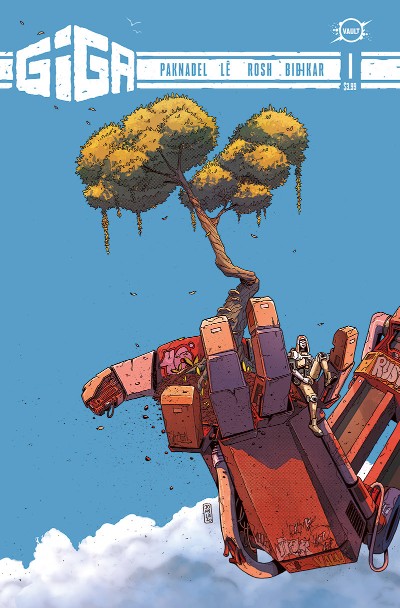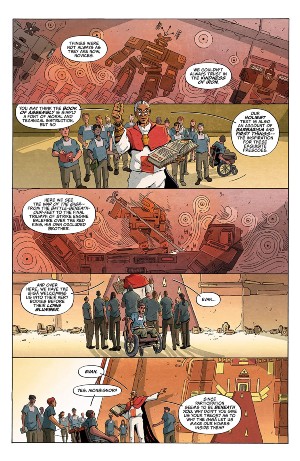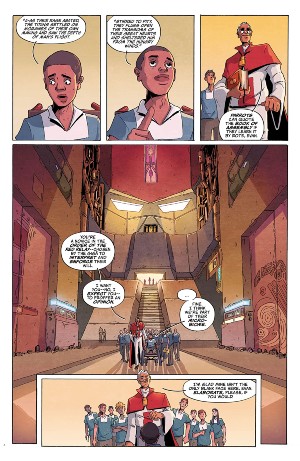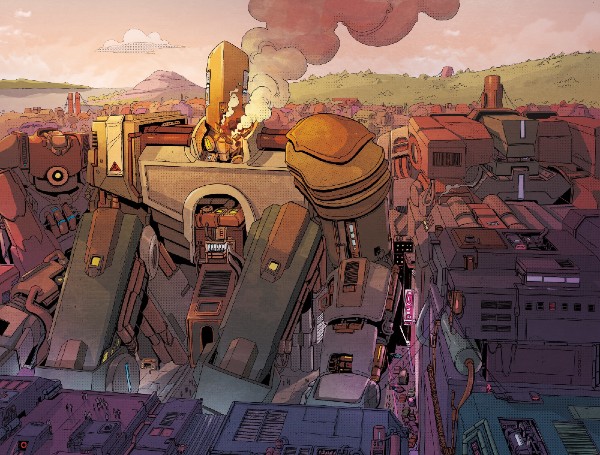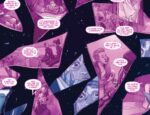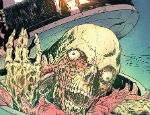The first issue of Giga from Vault Comics is, quite simply, an object lesson in how to write an opening chapter of a monthly comic. That’s an art that has been somewhat lost over the last decade or more as the dictates of the eventual trade paperback collection were prioritised over the momentum of the incremental delivery of the serialised storyline. Writer Alex Paknadel’s world-building here is measured and immersive, introducing us to the series’ premise and concepts through the experiences of its cast rather than forced exposition.
Centuries after a robot war between the mysterious giant robots known as the Giga ended with Strike Engine Baleforce vanquishing his brother the Red King, humanity has taken up residence in the bodies of these now inert mechanoid constructs. As we see in the opening pages, when a group of religious students (including Evan the book’s protagonist) are being taught by their Monsignor, a whole religion has built up around them in the subsequent years based on the revered Book of Assembly. This introduction is a prelude to tragedy, though, as an explosion tears through the class devastating their number. It’s a disaster that seems to have links to Evan’s friend Aiko.
Fast forward 13 years and Evan’s life has taken a turn for the worse. Now, he lives in a seedier side of town and is no longer associated with the religious order. Questions abound about the world of Giga a decade-plus on. What is the reason for the rogue nomad Giga behaving strangely in the forest region? What menace has the power to gut a dormant Giga? Who is Evan’s friend Laurel and what is her connection to the Giga? And what role will the Giga-hating group the Dusters play in what is to come?
In an extremely short page count the audience feels immediately conversant with the rich history, socio-political factions and sprawling cast that make up the world of Giga. Paknadel populates the book with a representative and diverse set of characters and, in a relatively brief on-page time, still manages to ensure our investment in them. There are so many hooks here in regards to the mysteries of Giga and the storylines they set up that grab our attention. But there are wider philosophical explorations too that appeal on another level entirely in regards to the theological foundations of the humans’ relationship with the Giga. They also pose the converse question of how the Giga see their connection with the humans.
John Lê’s visuals emphasise both the majesty and the squalor of the Giga city, and contrast their ominous presence with the smaller human stories that surround them. His epic visualisation of the characters’ world is undoubtedly a hugely significant part of the book’s appeal, creating a locale that is impressively daunting in scale and conception. That’s echoed by Rosh’s colours which showcase both the alien qualities of this environment but also the very human activity within it. As ever Aditya Bidikar’s contribution cannot be overstated – check out how his lettering choices add to the sense of disorientation in the explosion scene at the issue’s start for an example of that.
A new spin on the battling robots subgenre, Giga is a perfectly structured opening issue in what will undoubtedly prove to be one of the breakout serial comics of 2020. Take note because the buzz around this book is certainly not undeserved.
Alex Paknadel (W), John Lê (A), Rosh (C), Aditya Bidikar (L), Tim Daniel (D) • Vault Comics, $3.99
Review by Andy Oliver





